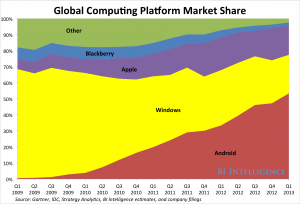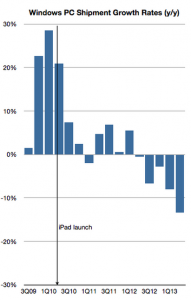Windows Monopoly is getting destroyed really quickly

In the late 1990s, a single technology company became so unfathomably rich and powerful–and so hellbent on dominating not just its own industry but a massive and rapidly growing new one–that the U.S. government dragged the company into court and threatened to break it up over anti-trust violations.
The case was settled, and the company, Microsoft, agreed to play nicer.
But as often happens in the technology industry, the world had nothing to worry about. What has really destroyed Microsoft’s choke hold on the global personal computing market over the past 15 years hasn’t been a legal threat but a market shift.
Just when it looked like Microsoft’s vision of the PC as the centre of the tech world would lead to the creation of the world’s first trillion-dollar company, the Internet came along.
And it washed over the PC industry like a tidal wave swallowing a pond.
In terms of market value, Microsoft’s loss of power has long been visible: The stock is still trading at about half the level it hit at the peak of the tech boom 13 years ago. The effects on the actual PC industry fundamentals have taken longer to develop, but they are also now crystal clear.
Microsoft’s “Windows monopoly” hasn’t been so much destroyed as rendered irrelevant. Thanks to the explosion of Internet-based cloud computing and smartphones, tablets, and other mobile gadgets, the once all-powerful platform of the desktop operating system has now been reduced to little more than a device driver. As long as your gadget can connect to the Internet and run some apps, it doesn’t matter what operating system you use.
The struggle of Microsoft and other PC-powered giants like Intel, Dell, and Hewlett-Packard to adapt to this new Internet-driven world has been obvious for years. But a look at some long-term charts and recent trends will really bring it home.
First, global device shipments. For the two decades through 2005, the personal computer was the only game in town, selling about 200 million units a year. But then smartphones and tablets came along. And now they dwarf the PC market.

This shift in personal computing device adoption, meanwhile, has radically diminished the power of the Windows operating system platform. As recently as three years ago, Microsoft’s Windows was still totally dominant–the platform that ran 70% of personal computing devices.
Now, thanks to the rise of Google’s Android and Apple’s iOS, Windows’ global share has been cut in half, to about 30%. More remarkably, Android is now a bigger platform than Windows.

Lastly, and most recently, this chart from analyst Horace Dediu of Asymco illustrates that the PC business is no longer just getting dwarfed by the explosion of smartphone and tablet sales… It has now actually begun to shrink.
Now that people have a choice of devices, it turns out that a full-blown personal computer is often not the most cost-effective, convenient, or simplest way to do what a user wants to do. Instead of being the centre of the personal computing world, in other words, the PC is becoming a specialised office-productivity device.

The news for Microsoft is not all bad. The company has been quite successful at moving from a “unit-driven” sales model to a licensing model, in which companies pay a fee per user per year rather than buying a perpetual licence with each new computer. And Microsoft’s Office franchise is still extraordinarily profitable and dominant, in part because Google, Apple, and other more Internet-centric companies have made so little investment in their competitive products.
But only 15 years after the government went after Microsoft for anti-trust violations, the idea that the company ever had a “monopoly” on anything is hard to to even understand. And the outlook for Windows, and the traditional PC business in general, seems sure to get even worse going forward.
